Mixed-Integer Linear Programming Model to Assess Lithium-Ion Battery Degradation Cost
Abstract
:1. Introduction
1.1. Background
1.2. Related Works and Research Gap
1.3. Contributions
2. Multi-Factor Battery Degradation Cost Model
2.1. Degradation Impact Factors and Dispatch Power
2.1.1. Influence of the Depth of Discharge (DOD)
2.1.2. Influence of the Average State of Charge
2.1.3. Influence of the Charge and Discharge Currents (I)
2.2. Lithium-Ion Battery Dataset
2.3. Battery Degradation Cost Model: Example
2.4. Constraints of the Battery Cost Model
3. Optimization Problem
Objective Function
4. Results
4.1. Contracted Demand
- • Sub scenario 1: Contracted demand of 200 kW (100%).
- • Sub scenario 2: Contracted demand of 100 kW (50%).
- • Sub scenario 3: Contracted demand of 20 kW (10%).
4.2. Investment Cost
- • Sub scenario 1: Investment Cost USD 120,000.00.
- • Sub scenario 2: Investment Cost USD 200,000.00.
- • Sub scenario 3: Investment Cost USD 400,000.00.
4.3. Initial SOC
- • Sub scenario 1: initial SOC of 20%.
- • Sub scenario 2: initial SOC of 50%.
- • Sub scenario 3: initial SOC of 80%.
5. Discussion
6. Conclusions
Author Contributions
Funding
Institutional Review Board Statement
Informed Consent Statement
Data Availability Statement
Acknowledgments
Conflicts of Interest
Nomenclature
| Indexes | |
| B | Index of batteries, running from 1 to nB |
| E | Index of elements, running from 1 to nE |
| G | Index of fueled generators, from 1 to nFG |
| S | Index of sheddable loads, running from 1 to nSL |
| T | Index of time step, running from 1 to nT |
| Parameters | |
| Ag | Angular fuel consumption (Brazilian real (BRL)/kWh) |
| Bg | Linear fuel consumption (BRL/h) |
| BPt | Buying energy price (from utility) (BRL/kWh) |
| CD | Unbalancing (power deficit) cost (BRL/kW) |
| CE | Unbalancing (power excess) cost (BRL/kW) |
| DT | Duration between two time steps (h) |
| FCg | Fuel cost (BRL/L) |
| IDP | Power deviation inhibition cost (BRL/kWh) |
| MCe | Maintenance cost of element e |
| nB | Number of batteries |
| nD | Number of dispatchable elements (nFG + nB + nSL + grid) |
| nE | Total number of elements in the system (nFG + nPV + nB + nFL + nSL + grid) |
| nFG | Number of fueled generators |
| nFL | Number of fixed loads |
| nPV | Number of photovoltaic units |
| nSL | Number of sheddable loads |
| nT | Number of time steps within the planning horizon |
| nW | Number of wind power generator units |
| OPt | Demand surpassing cost (BRL/kW) |
| Plimt | Demand limit during time t (kW) |
| PSLs,t | Power prediction of sheddable load s (kW) |
| SDPs,t | Shut-down price of sheddable load s (BRL/kWh) |
| SPt | Selling energy price (to utility) (BRL/kWh) |
| TOLt | Demand surpassing tolerance (%) |
| YCg | Start-up cost (BRL/h) |
| ZCg | Shut-down cost (BRL/h) |
| Continuous Variables | |
| dpd,t | Power variation at time t in element d (kW) |
| pbut | Power bought from utility at time t (kW) |
| pdeft | Power deficit in the system at time t (kW) |
| pdot | Power exceeding extra demand tolerance at time t (kW) |
| pexct | Power excess in the system at time t (kW) |
| psut | Power sold to utility at time t (kW) |
| pg,t | Generator g power at time t (kW) |
| Binary Variables | |
| ue,t | Equal to 1 if element e is on |
| udot | Equal to 1 for demand surpass |
| ug,t | Equal to 1 if generator is on |
| yg,t | Equal to 1 if generator g is starting up |
| zg,t | Equal to 1 if generator g is shutting down |
| uc,t | Equal to 1 if load is on |
References
- Jiayi, H.; Chuanwen, J.; Xu, R. A review on distributed energy resources and microgrid. Renew. Sustain. Energy Rev. 2008, 12, 2472–2483. [Google Scholar] [CrossRef]
- Shen, J.; Jiang, C.; Li, B. Controllable load management approaches in smart grids. Energies 2015, 8, 11187–11202. [Google Scholar] [CrossRef] [Green Version]
- Kumar, G.V.B.; Palanisamy, K. A review on microgrids with distributed energy resources. In Proceedings of the Innovations in Power and Advanced Computing Technologies (i-PCAT), Vellore, India, 22–23 March 2019. [Google Scholar] [CrossRef]
- Xu, Y.; Wang, Y.; Zhang, C.; Li, Z. Coordination of Distributed Energy Resources in Microgrids, 3rd ed.; The IET London: London, UK, 2021; pp. 3–32. [Google Scholar]
- Katiraei, F.; Iravani, R.; Hatziargyriou, N.; Dimeas, A. Microgrids management. IEEE Power Energy Mag. 2008, 6, 54–65. [Google Scholar] [CrossRef]
- Choi, M.E.; Kim, S.W.; Seo, S.W. Energy management optimization in a battery/supercapacitor hybrid energy storage system. IEEE Trans. Smart Grid 2012, 3, 463–472. [Google Scholar] [CrossRef]
- Ku, T.T.; Li, C.S. Implementation of battery energy storage system for an island microgrid with high PV penetration. IEEE Trans. Ind. App. 2021, 57, 3416–3424. [Google Scholar] [CrossRef]
- Serban, I.; Marinescu, C. Control strategy of three-phase battery energy storage systems for frequency support in microgrids and with uninterrupted supply of local loads. IEEE Trans. Power Electron. 2014, 29, 5010–5020. [Google Scholar] [CrossRef]
- Tan, X.; Li, Q.; Wang, H. Advances and trends of energy storage technology in microgrid. Int. J. Elect. Power Energy Syst. 2013, 44, 179–191. [Google Scholar] [CrossRef]
- Hossain, E.; Faruque, H.M.R.; Sunny, M.S.H.; Mohammad, N.; Nawar, N. A comprehensive review on energy storage systems: Types, comparison, current scenario, applications, barriers, and potential solutions, policies, and future prospects. Energies 2020, 13, 3651. [Google Scholar] [CrossRef]
- Chaudhary, G.; Lamb, J.J.; Burheim, O.S.; Austbo, B. Review of energy storage and energy management system control strategies in microgrids. Energies 2021, 14, 4929. [Google Scholar] [CrossRef]
- Huang, Z.; Yang, F. Quality classification of lithium battery in microgrid networks based on smooth localized complex exponential model. Complexity 2021, 2021, 6618708. [Google Scholar] [CrossRef]
- Garmabdari, R.; Moghimi, M.; Yang, F.; Gray, E.; Lu, J. Multi-objective energy storage capacity optimization considering microgrid generation uncertainties. Elec. Power Energy Syst. 2020, 119, 105908. [Google Scholar] [CrossRef]
- Ahsan, A.; Zhao, Q.; Khambadkone, A.M.; Chia, M.H. Dynamic battery operational cost modeling for energy dispatch. In Proceedings of the 2016 IEEE Energy Conversion Congress and Exposition (ECCE), Milwaukee, WI, USA, 18–22 September 2016. [Google Scholar] [CrossRef]
- Koller, M.; Borsche, T.; Ulbig, A.; Andersson, G. Defining a degradation cost function for optimal control of a battery energy storage system. In Proceedings of the 2013 IEEE Grenoble Conference, Grenoble, France, 16–20 June 2013. [Google Scholar] [CrossRef]
- Chen, C.; Duan, S.; Cai, T.; Liu, B.; Hu, G. Optimal allocation and economic analysis of energy storage system in microgrids. IEEE Trans. Power Electron. 2011, 26, 2762–2773. [Google Scholar] [CrossRef]
- Larsson, P.; Borjesson, P. Cost Models for Battery Energy Storage Systems. Bachelor’s Thesis, KTH School of Industrial Engineering and Management, Stockholm, Sweden, 2018. [Google Scholar]
- Abdulla, K.; Hoog, J.; Muenzel, V.; Suits, F.; Steer, K.; Wirth, A.; Halgamuge, S. Optimal operation of energy storage systems considering forecasts and battery degradation. IEEE Trans. Smart Grid 2018, 9, 2086–2096. [Google Scholar] [CrossRef]
- Goebel, C.; Hesse, H.; Schimpe, M.; Jossen, A.; Jacobsen, H.A. Model-based dispatch strategies for lithium-ion battery energy storage applied to pay-as-bid markets for secondary reserve. IEEE Trans. Power Syst. 2017, 32, 2724–2734. [Google Scholar] [CrossRef]
- Chaturvedi, N.A.; Klein, R.; Christensen, J.; Ahmed, J.; Kojic, A. Algorithms for advanced battery-management systems. IEEE Control. Syst. Mag. 2010, 30, 49–68. [Google Scholar] [CrossRef]
- Muenzel, V.; Hoog, J.; Brazil, M.; Vishwanath, A.; Kalyanaraman, S. A multi-factor battery cycle life prediction methodology for optimal battery management. In Proceedings of the 2015 ACM Sixth International Conference on Future Energy Systems, Bangalore, India, 14–17 July 2015. [Google Scholar] [CrossRef]
- Burzynski, D.; Pietracho, R.; Kasprzyk, L.; Tomczewski, A. Analysis and modeling of the wear-out process of a lithium-nickel-manganese-cobalt cell during cycling operation under constant load conditions. Energies 2019, 12, 3899. [Google Scholar] [CrossRef] [Green Version]
- Omar, N.; Monem, M.A.; Firouz, Y.; Salminen, J.; Smekens, J.; Hegazy, O.; Gaulous, H.; Mulder, G.; Bossche, P.V.; Coosemans, T.; et al. Lithium iron phosphate based battery—Assessment of the aging parameters and development of cycle life model. Appl. Energy 2014, 113, 1575–1585. [Google Scholar] [CrossRef]
- Nguyen, T.A.; Crow, M.L. Stochastic optimization of renewable-based microgrid operation incorporating battery operation cost. IEEE Trans. Power Syst. 2016, 31, 2289–2296. [Google Scholar] [CrossRef]
- Murnane, M.; Ghazel, A. A closer look at state of charge (SOC) and state of health (SOH) estimation techniques for batteries. Analog Devices 2017, 2, 426–436. [Google Scholar]
- Ecker, M.; Nieto, N.; Kabitz, S.; Schmalstieg, J.; Blanke, H.; Warnecke, A.; Sauer, D.U. Calendar and cycle life study of Li(NiMnCo)O2-based 18650 lithium-ion batteries. J. Power Sources 2014, 248, 839–851. [Google Scholar] [CrossRef]
- Makohin, D.G.; Gloria, L.L.; Zeni, V.S.; Pica, C.Q.; Neto, E.P.A.; Arend, F.G.; Asami, D.Y.; Heraldo, E. Design and implementation of a flexible microgrid controller through mixed integer linear programming optimization. In Proceedings of the 9th IEEE International Symposium on Power Electronics for Distributed Generation Systems (PEDG), Charlotte, NC, USA, 25–28 June 2018. [Google Scholar]
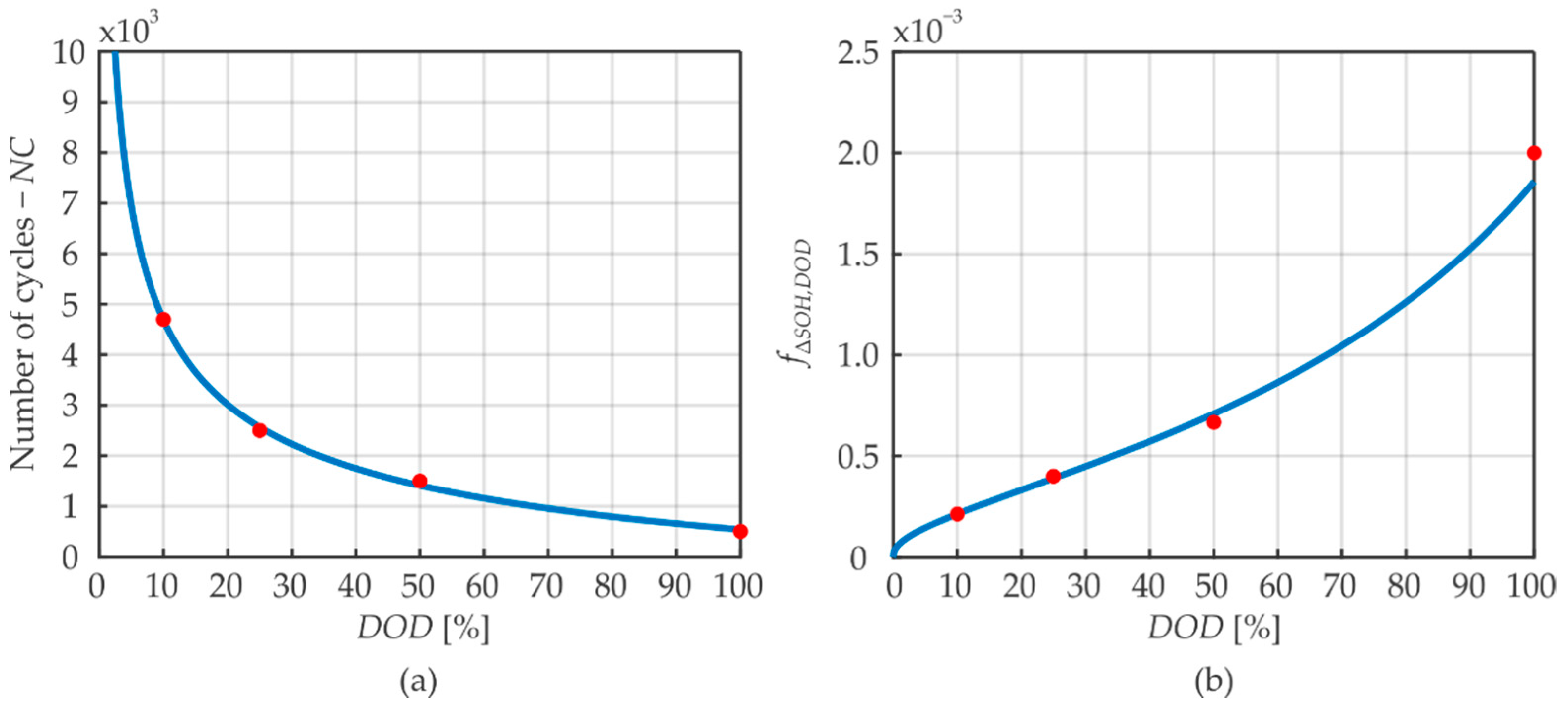

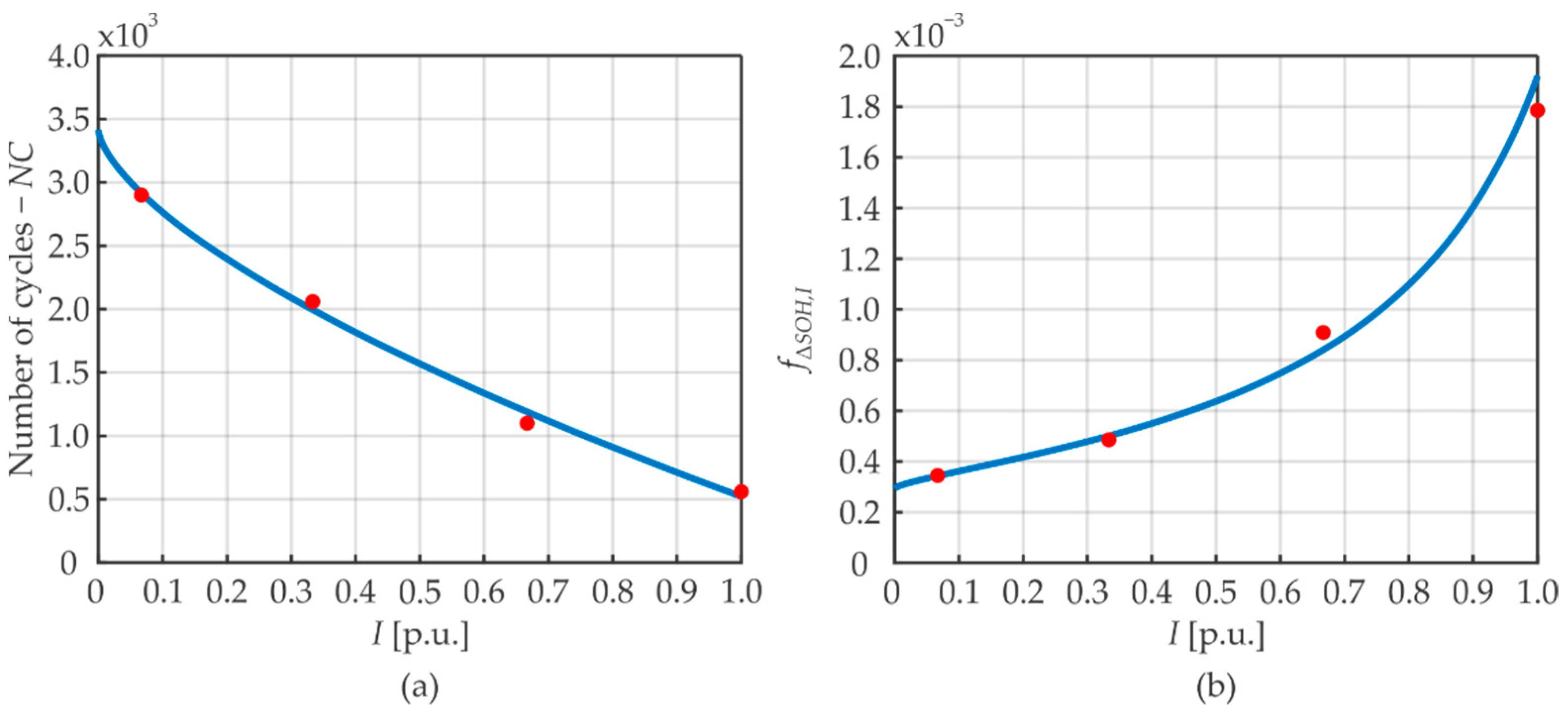
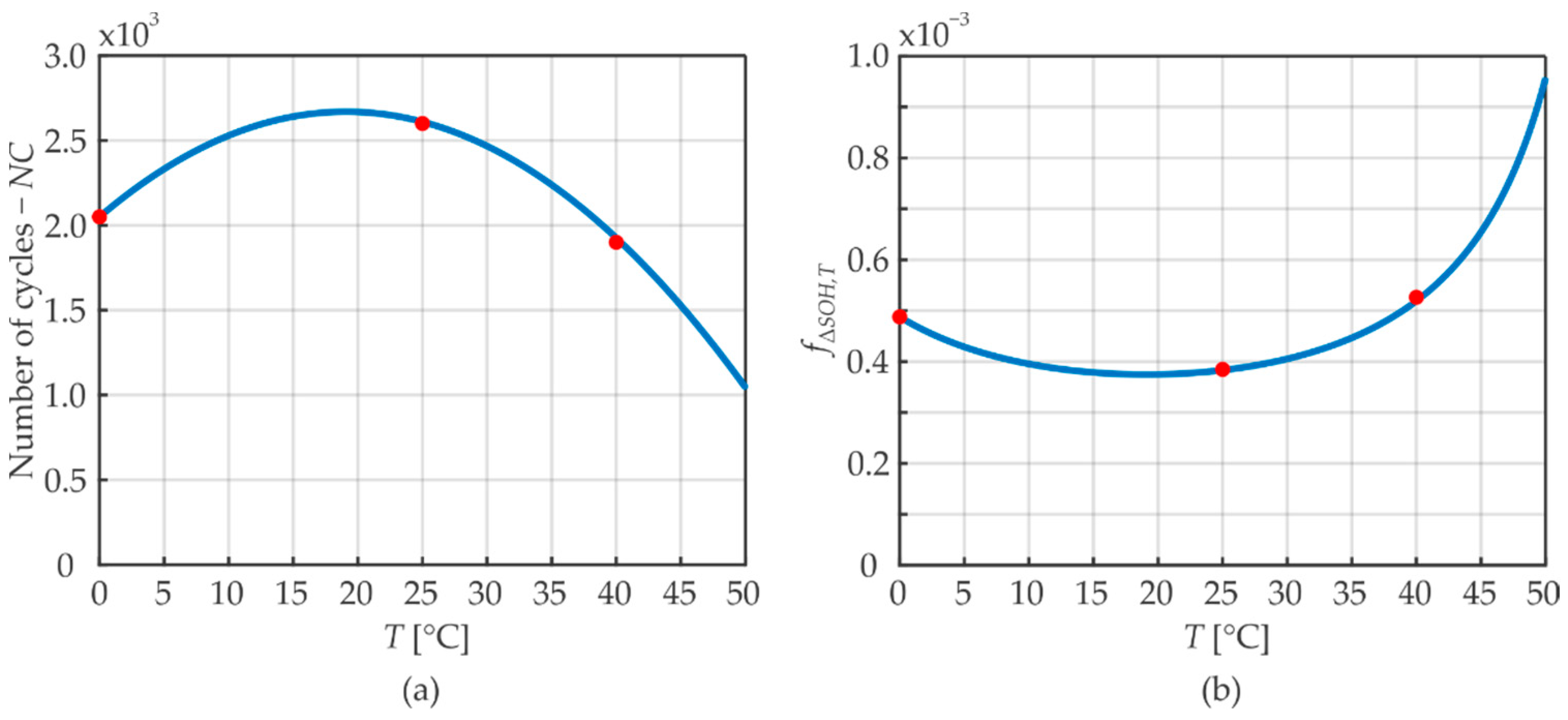
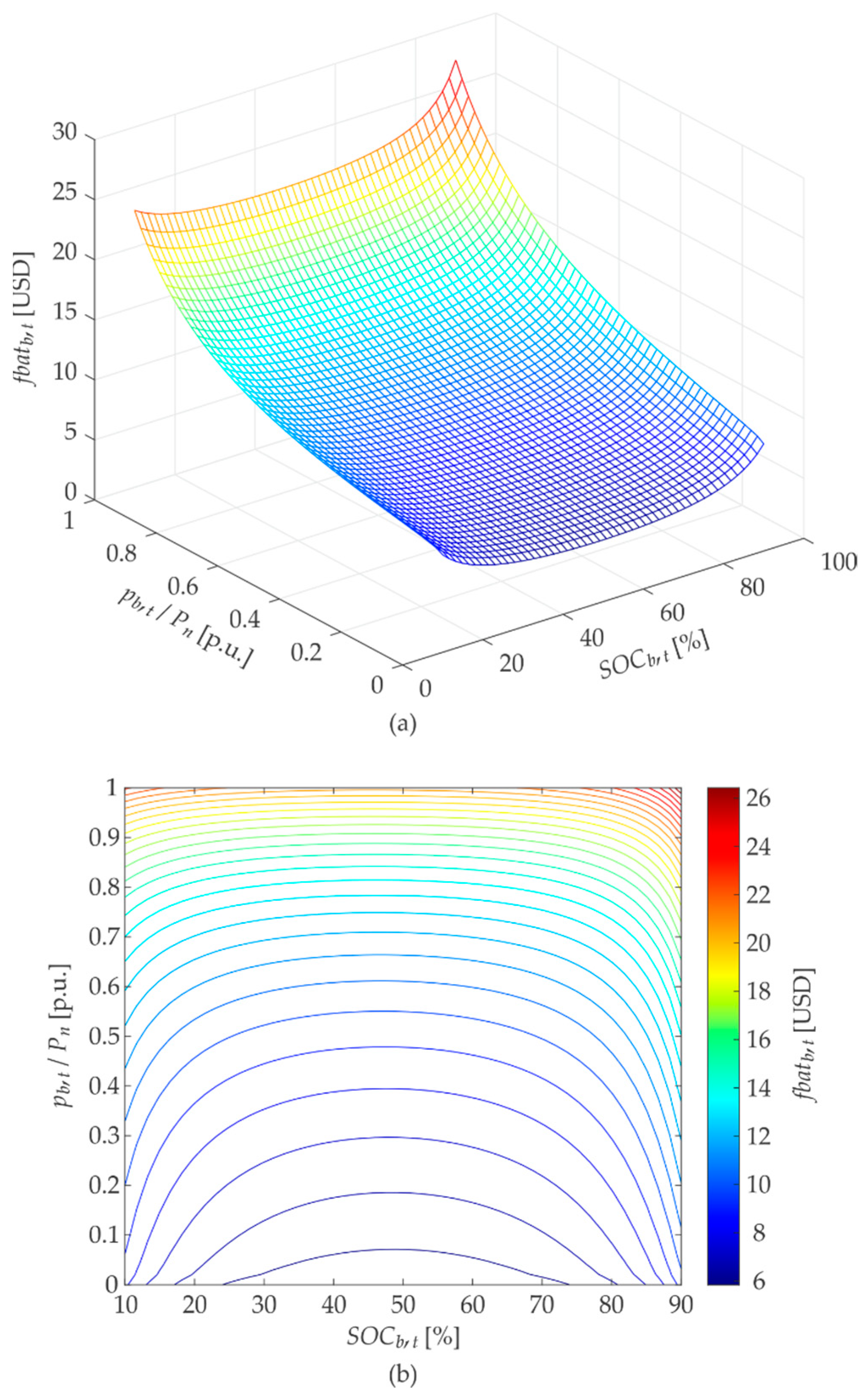

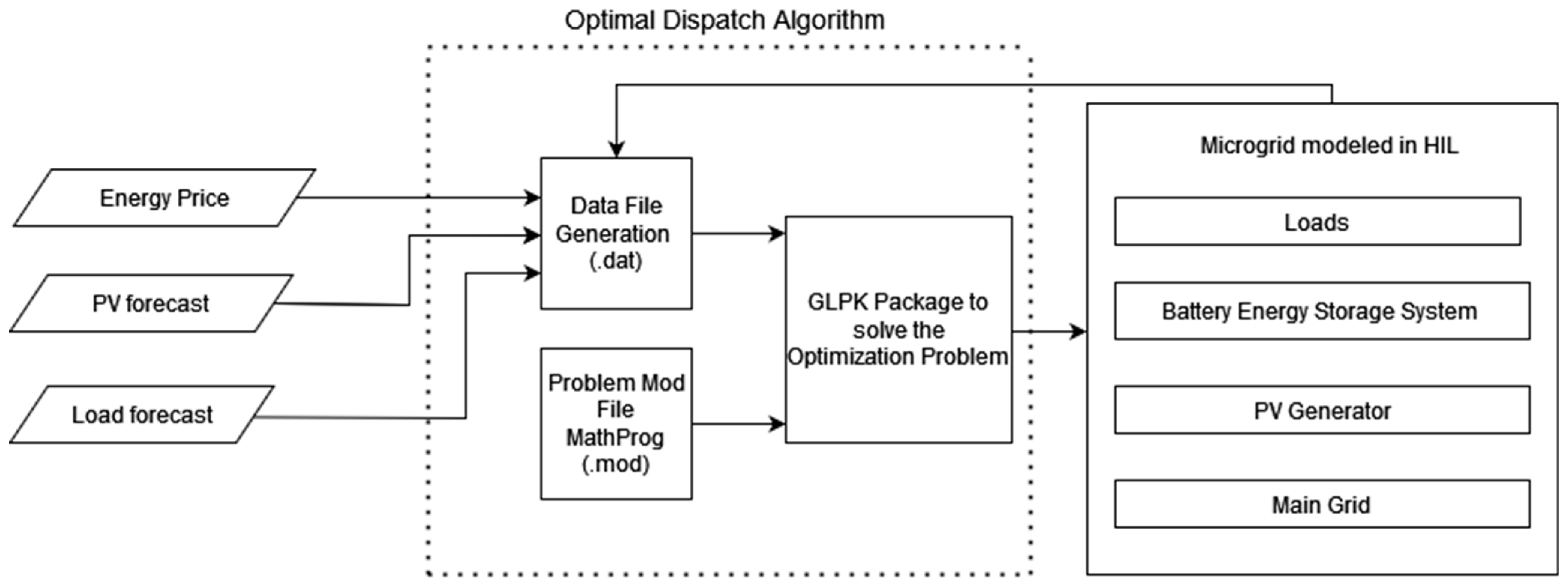








| Parameter | α | β | γ |
|---|---|---|---|
| DOD | 17,390 | −0.4052 | −2153 |
| −1.378 | 135.01 | 501.3 | |
| −2894 | 0.6485 | 3415 | |
| T | −1.717 | 64.92 | 2050 |
| Variable | Value |
|---|---|
| Rated power (Pn) | 180 kW |
| Rated voltage (Vn) | 1080 V |
| Rated capacity (Cn) | 200 Ah |
| Investment cost (cb) | USD 400,000.00 |
| Initial SOH (SOHbms) | 100% |
| Discretization interval (Δt) | 5/60 h |
| Variable | Value |
|---|---|
| PV power | 99 kW |
| Loads power | 240 kW |
| BESS power | 180 kW |
| Minimum SOC | 10% |
| Maximum SOC | 100% |
| BESS investment cost (default) | USD 400,000.00 |
| Initial SOC (default) | 80% |
| Contracted demand (default) | 200 kW |
Publisher’s Note: MDPI stays neutral with regard to jurisdictional claims in published maps and institutional affiliations. |
© 2022 by the authors. Licensee MDPI, Basel, Switzerland. This article is an open access article distributed under the terms and conditions of the Creative Commons Attribution (CC BY) license (https://creativecommons.org/licenses/by/4.0/).
Share and Cite
Oliveira, D.B.S.; Glória, L.L.; Kraemer, R.A.S.; Silva, A.C.; Dias, D.P.; Oliveira, A.C.; Martins, M.A.I.; Ludwig, M.A.; Gruner, V.F.; Schmitz, L.; et al. Mixed-Integer Linear Programming Model to Assess Lithium-Ion Battery Degradation Cost. Energies 2022, 15, 3060. https://doi.org/10.3390/en15093060
Oliveira DBS, Glória LL, Kraemer RAS, Silva AC, Dias DP, Oliveira AC, Martins MAI, Ludwig MA, Gruner VF, Schmitz L, et al. Mixed-Integer Linear Programming Model to Assess Lithium-Ion Battery Degradation Cost. Energies. 2022; 15(9):3060. https://doi.org/10.3390/en15093060
Chicago/Turabian StyleOliveira, Débora B. S., Luna L. Glória, Rodrigo A. S. Kraemer, Alisson C. Silva, Douglas P. Dias, Alice C. Oliveira, Marcos A. I. Martins, Mathias A. Ludwig, Victor F. Gruner, Lenon Schmitz, and et al. 2022. "Mixed-Integer Linear Programming Model to Assess Lithium-Ion Battery Degradation Cost" Energies 15, no. 9: 3060. https://doi.org/10.3390/en15093060
APA StyleOliveira, D. B. S., Glória, L. L., Kraemer, R. A. S., Silva, A. C., Dias, D. P., Oliveira, A. C., Martins, M. A. I., Ludwig, M. A., Gruner, V. F., Schmitz, L., & Coelho, R. F. (2022). Mixed-Integer Linear Programming Model to Assess Lithium-Ion Battery Degradation Cost. Energies, 15(9), 3060. https://doi.org/10.3390/en15093060










